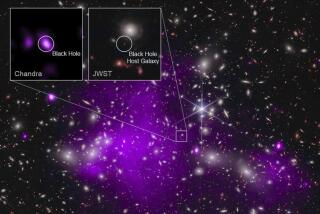Oldest Known Planet Is Detected
- Share via
WASHINGTON — Scientists using NASA’s Earth-orbiting Hubble Space Telescope said they have detected the oldest known planet in the universe, a 13-billion-year-old world about 2 1/2 times the mass of Jupiter.
It would also be the most distant planet discovered from Earth, about 5,600 light-years away in our own Milky Way galaxy, said Alan Boss of the Washington-based Carnegie Institution.
“This identification is a stunning revelation,” Boss said at a National Aeronautics and Space Administration briefing. “The idea that there is now evidence for a planet that was formed roughly 1 billion years after the Big Bang is just absolutely unprecedented.”
Earth is much younger, about 4.5 billion years old, according to estimates by geologists.
The newfound planet is in the center of a star cluster called M4 in the constellation Scorpius. Scientists first came across evidence of the planet in 1988, when a pulsar, or a neutron star spinning almost 100 times per second and emitting regular radio pulses, was detected in the center of the cluster.
A white dwarf star, or a star that has collapsed, was quickly found through its effect on the pulsar, and scientists soon saw evidence that a third object was orbiting the two stars. Researchers eventually determined that the third object was too small to be a star and must be a planet.
Its extreme age means “planets started forming much earlier in the universe than one would have thought,” said Harvey Richer, a professor of astronomy and physics at the University of British Columbia in Vancouver.
Evidence of about 115 “extrasolar” planets, which don’t revolve around Earth’s sun, had previously been discovered, all of them gas giants such as Jupiter or Saturn that are unlikely to support life as we know it.
Telescopes are not capable of directly observing planets outside the solar system. Rather, scientists measure the Doppler shift of stellar light to determine their presence.
Globular clusters lack heavier, metallic elements because they were formed so early in the history of the universe, and researchers had previously argued that they couldn’t contain planets. The most recent discovery may prove that planets could be common in the clusters, scientists said.
“What we think we’ve found is an example of the first generation of planets formed in the universe,” said Steinn Sigurdsson, an assistant professor of astronomy at Pennsylvania State University and one of the researchers who made the discovery.
The planet recently discovered is likely a gas giant with no solid surface and probably doesn’t have elements such as oxygen and carbon.
Sigurdsson said there were enough heavy elements in the M4 complex to have formed some terrestrial planets, like Earth and Mars, in orbit of the sun-like star.
He said it is theoretically possible that life could have formed on those planets about 12.5 billion years ago.
But when the sun-like star was pulled into orbit of the neutron star, any planets near the sun would have been destroyed. Only the gaseous planet, orbiting about 2 billion miles out, would have survived.
“Over a billion years ago, any near-in planet would have been wiped out,” said Sigurdsson. “But it could have been stable for 10 billion years before,” plenty of time for intelligent life to have formed.
If there was intelligent life on such a planet, he said, it was destroyed as the parent sun was pulled toward the neutron star.
“They would have seen it coming,” Sigurdsson said of any creatures that might then have been living on that planet.






